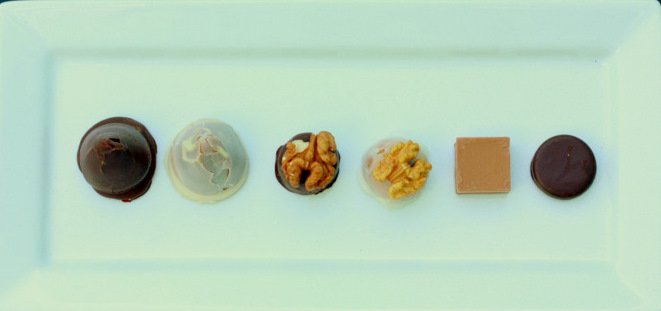Good evening dear friends! I hope you had a lovely week.
This week, we continue with our introduction to typical Argentinian sweets, the ones we, Argentinians, love and miss when we are abroad. Today, I bring you some of my favourite bite-sized sweets. All of them, except branch chocolate and nuts confit, can be found in any kiosk, so they are great for an almost guilt-free sugar rush moment. Also, all of them, except for “bocadito maroc” include dulce de leche, because most of my fellow country-men would agree that “a desert without dulce de leche is not desert”. I have changed quite a bit in this regard since living abroad, but try baking a birthday cake with buttercream, jam or lemon curd for an Argentinian child (or adult!) and you will be met with a face of sheer disappointment!
Let’s begin with Bocaditos Maroc, which are the bi-colour squares portrayed in the pictures above. They are made with a combination of peanut cream, milk and white chocolate. They are soft and truly melt in your mouth and, best of all, they are really easy to make at home so, if you want to give them a try, here’s how: Cover a square pan with foil. Process 100 grs of peeled roasted peanuts with 1 tablespoons of corn or canola oil until it reaches a pancake batter consistency. Melt 100 grs of milk chocolate and add 1/3 of the peanut cream to it. Mix well and place it in the pan, making sure it covers the pan evenly and smoothly. Bring to the fridge for about 15 minutes, so that the chocolate hardens. Melt 80 grs white chocolate and add another 1/3 of the peanut cream, mix well and pour it on top of the milk chocolate and peanut mixture. Put it in the fridge for another 15 minutes and, in the meantime, melt the remaining 100 grs of milk chocolate. Mix with the last 1/3 of peanut cream, and add it to the pan. Smooth the top with a spatula and place it in the fridge until hard. Once ready, remove from the pan, peel off the foil and cut into squares with a sharp knife (If you wet the knife in hot water, it will be easier to get a nice, clean-cut). And that’s all it takes!
The following treat is perhaps the most common of them all: Dulce de leche cones, or “Pinitos de dulce de leche”. They are simply, as you can see from the picture below, a truly decadent treat made of cookie, lots of dulce de leche disposed in a cone shape and covered in either dark or white chocolate.
If you live outside of Argentina and you are familiar with regular dulce de leche, you may be wondering how it is possible for the cones to keep their shape. The answer is this: the cones are not made with regular dulce de leche, but with dulce de leche repostero, or “baking dulce de leche”, which is firmer and thicker than the regular one (which has a jam-like consistency).
Dulce de leche repostero, unlike regular dulce de leche, is not made solely of milk, sugar and vanilla. Now, be warned, here comes a big surprise: Dulce de leche repostero has bean pulp (pulpa de frijoles) and cornstarch to give it its consistency. Argentinian friends, if you don’t believe me, go check the ingredients listed in a can…I did it back in November and couldn’t believe my eyes!
If you want to make it at home, you should know that the proportions are different from the ones for regular dulce de leche: apart from adding the above ingredients, it takes three times more sugar. So, for every 5 litres of milk (as I did in the original recipe), you will need 3 kg of sugar, 2 1/2 cups of bean pulp (made soaking the beans overnight, then boiling them until very soft and finally passing them through a sieve), 10 tablespoons of cornstarch, 1 vanilla bean and 1 tablespoon of cornstarch. The procedure is pretty much the same as for regular dulce de leche, except for the addition of the beans which has to be done after the milk and sugar mixture starts to thicken (see the first stage of browning of my earlier post on dulce de leche). Right after adding the bean pulp and mixing everything very well with a wooden spoon, you should also add the cornstarch previously diluted in half a cup of cold milk. Then let time run its course and after a few hours you should be able to enjoy wonderful baking dulce de leche!
Another special treat that I look forward to eating when I go home are nueces confitadas, or “nuts confit”:
There are many recipes and ways to make them, but most of them involve three ingredients: dulce de leche repostero (see why you should know how to make it? 😉 , walnuts and poured fondant. The most traditional way consists of surrounding a full walnut in a spoon of dulce de leche and covering it all with poured fondant. Some, however, do it in a different way (as the ones that you can see in the picture above), which consists in making a paste with dulce de leche repostero and processed walnuts, giving it a ball shape and covering each ball in either poured fondant or dark chocolate.
The following picture shows another personal favourite, called Bocadito cabsha:
They are made with host capsules (yes, like the host of catholic mass. In Argentina they can be bought at baking supplies stores), dulce de leche, glucose, rum, and chocolate. The procedure is very simple: you need to heat the glucose in a pan, together with the dulce de leche, remove the pan from heat and add the rum, and fill the capsules with this preparation being careful not to overflow them. Finally, cover the capsules in chocolate, let them cool down for it to harden and enjoy!
Finally, chocolate en rama, or branch chocolate:
If you are curious about how it is made, check this video where you can see a real maitre chocolatier at work.
See you next week, with the last post on Argentinian sweets and a few recipes!
Have a wonderful weekend!







Me lleve cabshas a Italia, aca no los compro nunca, pero alla me salvaron de los acntojos 😉
🙂
Hola!!!! Hace unos años estuve en Argentina y comí dulces increíbles. Soy una fan del dulce de leche, me vuelve loca perdida, así que esos pinitos son mis favoritas de tu selección de hoy 😉
Encantada de conocerte a través de Superstar. He leído tu historia y tenemos varias cosas en común, ja ja!!!
Un saludo desde Estocolmo 🙂
Los cabsha son una perdicion! Q lindo post para mostrar al mundo nuestro gusto por los bocados dulces! ya q estamos te pregunto: tenes alguna receta para hacer alfajores como los del post anterior? Ya se q no tendras la formula de Havanna (o si??? jajajaja) pero algo similar para imitar… gracias Marce, como spre! besotes
Gracias Pauli!
Tengo un par de recetas pero sólo las publicaré cuando haya podido probarlas, porque me gusta que lo que publico sea confiable y el que las haga pueda saber que le van a salir como en la foto 🙂
Hola Elena! Muchas gracias por pasar! Tambien es un placer conocerte a través de Superstar. Me encanta tu blog!